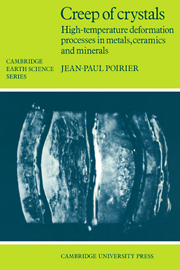Book contents
- Frontmatter
- Contents
- Preface
- 1 Mechanical background
- 2 The agents of deformation: lattice defects
- 3 Phenomenological and thermodynamical analysis of quasi-steady-state creep
- 4 Dislocation creep models
- 5 The effect of hydrostatic pressure on deformation
- 6 Creep polygonization and dynamic recrystallization
- 7 Diffusion creep, grain-boundary sliding and superplasticity
- 8 Transformation plasticity
- 9 Scaling and classification
- References
- Materials index
- Subject index
6 - Creep polygonization and dynamic recrystallization
Published online by Cambridge University Press: 06 October 2009
- Frontmatter
- Contents
- Preface
- 1 Mechanical background
- 2 The agents of deformation: lattice defects
- 3 Phenomenological and thermodynamical analysis of quasi-steady-state creep
- 4 Dislocation creep models
- 5 The effect of hydrostatic pressure on deformation
- 6 Creep polygonization and dynamic recrystallization
- 7 Diffusion creep, grain-boundary sliding and superplasticity
- 8 Transformation plasticity
- 9 Scaling and classification
- References
- Materials index
- Subject index
Summary
The most important microstructural evolution during creep consists in the formation of misoriented subgrains (polygonization) separated by dislocation walls. The walls result from the rearrangement of the geometrically necessary dislocations that accommodate the plastic incompatibilities between grains or between single crystalline sample and platens. The subgrain structure is in a state of dynamic evolution, walls being created, migrating under stress and being destroyed; the misorientation of the walls increases with strain until a recrystallized grain structure is created by rotation, without migration. For higher stresses and temperatures, the driving force for migration of the boundaries, as well as their mobility, increases and the boundaries may migrate. The subgrain size and the recrystallized grain size both depend only on the applied stress and decrease as the stress increases. Empirical relations between grain size or subgrain size and stress are found experimentally and are used to estimate the stress responsible for the natural deformation of rocks. However, the view that the subgrain or grain sizes are in equilibrium at a given stress is unfounded. The subgrain size is not an independent variable and has no real effect on the creep-rate unless it can be independently fixed. Grain refinement due to dynamic recrystallization does not seem sufficient to cause a change of creep mechanism from power-law to diffusion creep.
Generalities
The most conspicuous structural feature of high-temperature recovery creep of metals, ceramics and minerals, consists in the ‘fragmentation’ of crystals into ‘subgrains’.
Information
- Type
- Chapter
- Information
- Creep of CrystalsHigh-Temperature Deformation Processes in Metals, Ceramics and Minerals, pp. 169 - 193Publisher: Cambridge University PressPrint publication year: 1985
